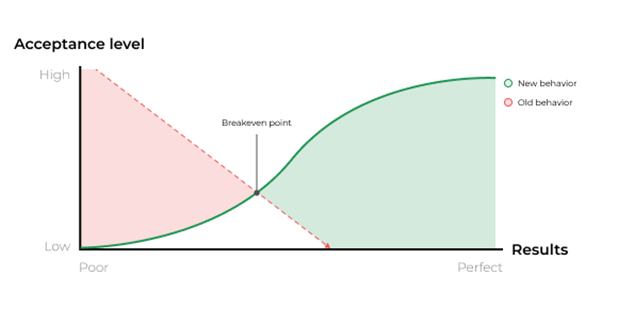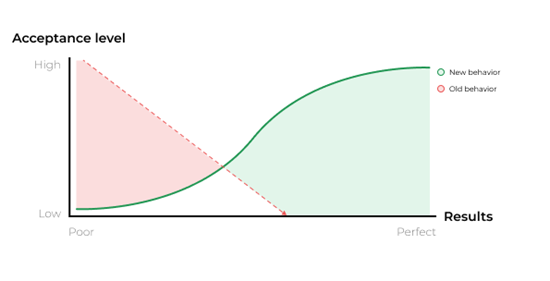
The Green Acceptance Model
This model is not perfect, it’s not sufficiently tested...
The Actee goals are for our games to “change the world”. It is the central part of our ethics. So, the wish for the model is that you will make it your own - tweak it, customize it to suit your games, plans, or whatever can serve the goal of changing the world to a better place in the sense of being more green.
(But remember to keep the references to me Leif Sørensen and Actee please)
Let's Dig In...
Look at the model, watch the explanation video and test this game if you want to skip the readings.

The Green Acceptance model will give a language about how to change everyday work situations to sustain our world in a better way. The model will offer an understanding of what happens to us when we make more green choices and what the key factors are to move ourselves, our colleagues, our partners, our production, our competitors, or any other situation we want to change to become greener.
The Green Acceptance model works see a video on the model here.
1. Acceptance (moving from - low acceptance to high acceptance).
2. Results / Goal / Time / Process, acceptance is always related to a wanted sustainable results. Moving from Poor, to Perfect.
Being great at something in the green context means you are moving towards something better for the world.
The Green Acceptance models are meant to be tools to measure the specific situation and create a goal for where to go if you try to change the sustainable agenda.
There are 2 axes to monitor if you want to make a green change:

Results
Imagine a company, wanting to reduce the emails being sent, due to energy consumption. In the beginning, people will find it funny and laughable and the acceptance for not sending an email will be very low and the result poor.
A bit later in the process, some people start accepting that "we don't send too many emails" but some people will still not comply with the new email action. The new situation has created more acceptance for the new green action and we are now getting higher on the left result axis. We live with people sending emails and not caring about the green agenda and those who do. Our green result is improving as we progress to the push area in the result level bar. The acceptance is much bigger now since we cope with both reactions to the new green email action.
After some time we want to improve even more to become high achievers on the green agenda and we need to have less acceptance of people sending unnecessary emails. As we progress further we will find ourselves accepting less and less of the behaviour not supporting the green agenda. Now we are moving even higher on the left axis as the acceptance line shift towards the left and towards the starting point of our green journey with everyone not accepting behaviour and not supporting the green email action.
Now imagine the green agenda you are working on within your life and replace the green email action with your theme...
Do you have a specific result you want to achieve?
Do you have the acceptance needed to make the next step?
Do you know if you are in the poor, push, or power area in the 3P´s?
I believe - if you want to make a green impact you will need to know what you want to achieve and the expected results from being greener. You will also need to know the acceptance level - are backed up by people achieving the result with you?
Results like “we want to be greener” are not satisfying and a green goal needs to be specific, and you need to be able to measure the progress. (Kotter, J. P. 2012. Maurer, R. 2001)
As in any change (Cycle of change L. Sørensen – S. Gudiksen 2021), the results on the 3P´s and acceptance must be revisited and changed as your progress in changing the world for the better. (don't forget to use games to support you)
Acceptance
Acceptance can be looked at as knowledge, resistance, willingness and will be influencing the result of the green changes you want to make.
If you have a high acceptance towards all opinions and behaviors, you might not be able to achieve a high result since less acceptance also means goodbye to old bad habits. Advancing to perfect - in the model means not accepting as a person or as a team any wrong priorities. To get people behind the green behavior we need to ensure we know why the green focus is at play or get rid of not wanting to change due to believe or ethics.
But reactions in a group or a person can be unpredictable but looking at the change theory one potential risk can be a lack of knowing how to do things differently or and not believing in the ethics of more green behaviors. Very similar to resistance reactions and motivational factors.
Acceptance of ethics is related to beliefs and culture for a person, company, or team.
It is important to understand that acceptance comes in phases related to results. It is sliding, can jump, move fast or move very slow. Knowing where you are on the sustainable result and Acceptance might help you create a better world.
let´s look at the model from a process perspective
In the beginning, you will have a poor result -There is a huge need for a lot of acceptance to cope with the new and old at the same time.
Midway means we have started to make green changes and see some improvement and reach a better sustainable level and people start making the right choices.
to the end and to get to a perfect level, acceptance will (need to) shift to less acceptable to the old way of working.
We have added the model to the theory section with the 40 other theories available in our games. we will also add the theory to the games where it makes sense for the game. When you create your own game you can add the model to your games from now on.
I hope the model makes sense to you as it does to me and the companies using it. Don´t forget to test the game and quiz here:
Sign up for free to create your own games here
Thanks for wanting to think with me -
Results, changes, and behavior is inspired by:
Actee partner-day 2021 The green group
Edyta Ponarad linkedin.com/in/edyta-ponarad-5b24171
Steffen Löfvall linkedin.com/in/lofvall
Pamela O’Hanlon
Justyna Rozmysłowska-Wize linkedin.com/in/justyna-rozmysłowska-wize-27544a79
Following improvement suggestions from
Steffen Löfvall - Advisor and external lecturer in strategy, co-creation and change management linkedin.com/in/lofvall
Ian Sturgess - Senior Facilitator & Coach linkedin.com/in/iansturgess
Ida Schroll Bjørnsbo Client Innovato Passionate about Innovation & Sustainability linkedin.com/in/ida-schroll-bjørnsbo-a570aa13b
Other inspirations
Gudiksen, S., & Sørensen, L. (2017, June). Value-based leadership: Game tool as bridge maker. In ISPIM Innovation Symposium (p. 1). The International Society for Professional Innovation Management (ISPIM).
Maurer, R. (2001). Build a foundation for change. The Journal for Quality and Participation, 24(3), 38. for discussing the model with me.
Schein, E. H. (1983). Organizational Culture: A Dynamic Model. ALFRED P SLOAN SCHOOL OF MANAGEMENT CAMBRIDGE MA.
Kotter, J. P. (2012). Leading change. Harvard business press.
UN the 17 Sustainable Goals.
